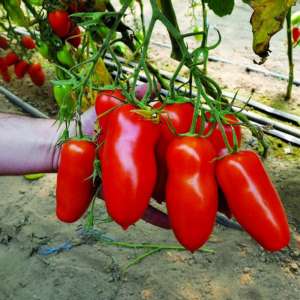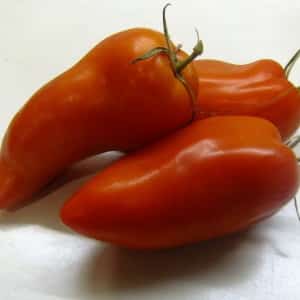An unusual tomato with juicy pulp and excellent taste - “Cornabel f1”
Everyone has long been accustomed to the variety of colors of tomatoes. Red, orange, yellow and brown tomatoes have become commonplace. The round, flattened and elongated shape of a tomato will also not surprise anyone. But French breeders of the Vilmorin company have developed a new unusual form of tomato - Cornabel f1.
Description of the hybrid
 Cornabel f1 is a tomato shaped like a bell pepper. From a distance or in a photo, you can even confuse them with pepper.
Cornabel f1 is a tomato shaped like a bell pepper. From a distance or in a photo, you can even confuse them with pepper.
Distinctive features
A distinctive feature is not only the shape of the tomato, but also its belonging to indeterminate varieties. These are varieties that grow continuously throughout the season. Since the bushes grow tall, they need to be shaped and tied up.
Fruit characteristics and yield
The harvest from such a powerful bush will be much greater than from an ordinary one. This variety is characterized by increased fertility. Tomatoes grow in clusters of 5-7 pieces. Fruits are 12-15 cm long.
The average weight of one tomato is 0.2 kg; especially large ones can weigh about 0.5 kg.
Despite the fact that the fruits themselves are dense like peppers, their flesh is juicy and sweet. The core is fleshy. The yield from one bush can reach 5 kg.
How to grow seedlings
Cornabel tomatoes are grown both in the garden and in greenhouses.
Seedlings are grown in the same way as for conventional tomato varieties.
Seed preparation
Since this is a first-generation hybrid variety, the seeds must be purchased in specialized stores. Before sowing, the seeds are soaked in water for 20 minutes. The floating seeds are removed, and the rest are used for sowing. You can keep the seeds in a weak solution of potassium permanganate for disinfection.
Before planting, the seeds are germinated a little. To do this, place soaked gauze or cotton wool in a plate, spread the seeds over it in a thin layer and cover with damp gauze. As soon as the seeds hatch, you can begin planting.
Container and soil
Seeds that are ready for planting can be planted in convenient containers or directly into the soil. For planting, you can take not very deep plastic containers or wooden boxes. Plant the seeds in soil prepared in advance and fertilized with organic matter. You can add saltpeter and a little superphosphate to the soil.
Sowing
 The time for sowing tomato seeds is the end of February - March. This is done 50-60 days before planting in open ground. The seeds hatched on gauze are placed to a depth of 2 cm and covered with a thin layer of damp soil.
The time for sowing tomato seeds is the end of February - March. This is done 50-60 days before planting in open ground. The seeds hatched on gauze are placed to a depth of 2 cm and covered with a thin layer of damp soil.
The containers with the planted seeds are covered with film and placed in a warm and bright place. After the seeds germinate and emerge from the ground, the film can be removed.
Growing and care
After two leaves appear, the seedlings are picked into pots with a capacity of at least 0.5 liters. A separately planted seedling will grow larger and more powerful. Seedlings in pots should only be kept until flowering begins.
Before transplanting into open ground, the sprouts are hardened. To do this, seedlings are placed briefly at night on the balcony or in front of an open window. Immediately before planting, leave overnight.Tomato seedlings can be planted in open ground when the ground warms up to 15 degrees at a depth of 10 cm. This happens around May.
How to grow
When the sprouts become stronger and reach a height of 30 cm, they can be transplanted into open ground. Before planting, the beds must be loosened and weeded to remove weeds. The area for tomatoes should be sunny.
Landing
In the area allocated for planting, make holes to a depth of 15 cm and spill them with water.. Since the Cornabel f1 hybrid is in constant growth, the seedlings are planted 0.5 m apart, and a gap of up to 1 meter is made between the rows. Thus, no more than two bushes should grow per 1 sq.m.
The seedlings are carefully removed from the pots and placed in holes prepared in advance. Cover with soil, without pressing down the soil too much, so as not to damage the roots. Water again with warm water.
Care
For active growth, tomatoes need to be provided proper watering. When the seedlings have not yet grown strong, 0.5 liters of water for each plant is enough. As the bush grows, the amount of water is increased. It is necessary to water with settled warm water. Watering in the sun is not allowed, as it will burn the leaves and stem.
The optimal time for watering is morning or evening. Watering is carried out as the earthen clod dries. Excessive watering can lead to fungal diseases and blackleg. The soil should not be allowed to dry out. In this case, growth will stop and the plant will die.
Planted plants must be regularly weeded and the earthen ball fluffed up. This will have a positive effect on the ventilation of the root area of the plant.
 For the Cornabel variety, to form a beautiful bush, you must definitely pinch off the excess stepsons. Weak branches will produce small fruits. The top of the bush also needs to be pinched for the growth of large side branches. The growth of the stepsons must be constantly monitored as the bush grows, since their growth weakens the mother bush, robbing it of nutrients. It is recommended to form the plant using a two-stem system.
For the Cornabel variety, to form a beautiful bush, you must definitely pinch off the excess stepsons. Weak branches will produce small fruits. The top of the bush also needs to be pinched for the growth of large side branches. The growth of the stepsons must be constantly monitored as the bush grows, since their growth weakens the mother bush, robbing it of nutrients. It is recommended to form the plant using a two-stem system.
For this hybrid, a garter to a support is also necessary, since the bush grows tall and powerful and can simply collapse under the weight of the fruit. To do this, they dig in high supports and, as they grow, tie the stem with soft ropes.
7 days after planting, seedlings are produced feeding. The first feeding is done with a weak solution of chicken manure or cow manure. Subsequently, watering is carried out with a moderate content of mineral fertilizers. Excessive nitrogen content leads to abundant green growth. An excess of potassium prevents the bush from absorbing calcium, and can increase the fruit mass so much that the growth of the bush itself slows down.
Fertilizing is carried out as soon as the color of the foliage begins to change and the growth of the stem slows down.
Don’t forget about regular weeding, because only in soft, loose soil can you achieve a good harvest. Weeds pull minerals and organic matter necessary for tomatoes from the ground. Pests and harmful microorganisms appear in clogged areas.
Features of cultivation and possible difficulties
Kornabel for open ground is grown by seedlings. Before the onset of stable heat, cover the seedlings at night to prevent hypothermia. Growing this hybrid is not much different from growing conventional tomato varieties. The only difficulty is that the bush must be regularly shaped and, as the stem grows, constantly tied to a support.
Diseases and pests
The hybrid has good resistance to diseases and pests. But if you violate cultivation practices, diseases may arise - late blight, gray rot, black leg, leaf mosaic, bacteriosis.
Late blight appears with increased dampness and lack of loosening of the soil. The appearance of gray rot is promoted by fungi that are found in the soil at high atmospheric humidity. The cause of blackleg is also dampness. The mosaic on the leaves appears due to aphids. Most often this happens after a pick. Affected leaves should be picked and destroyed. The bushes are treated with fungicides: Fundazol, Maxim, Barrier, Skor.
With rare weeding, plants are affected by pests such as: whitefly, spider mites, armyworms, nematodes, and caterpillars. To combat them, you can use the drugs Actellik, Aktara, Bi 58-new.
The nuances of growing in open ground and in a greenhouse
For growing in a greenhouse, seedlings are prepared one and a half months earlier than for open ground. If the greenhouse is heated, seedlings can be planted as early as April.
If polyethylene film is used for covering in the greenhouse, planting should be done later - in early May. At the same time, seedlings are also planted in polycarbonate greenhouses.
If there is no heating or covering material in the greenhouse, then planting is carried out at the end of May.
Despite greenhouse conditions, the variety performs better in open ground.
Harvesting and application

The harvest begins 2 months after planting the seedlings. Kornabel is a high-yielding hybrid with a long fruiting period. Tomatoes are harvested as they ripen. During the season, up to 5 kg of crop is harvested from one bush.
The variety tolerates long-term transportation well. Keeps well fresh in the refrigerator for about a month. Juices, all kinds of sauces, and salads are made from tomatoes.
It can be preserved well, since the dense skin does not crack when poured with boiling water. A tomato of such an unusual shape will always decorate a holiday table.
Such fruits can be dried and dried. Sun-dried tomatoes are considered an expensive delicacy.
Advantages and disadvantages of the variety
Advantages of the Cornabel variety:
- high productivity;
- unusual beautiful appearance;
- identical fruits of the correct shape;
- long period of tomato ripening;
- resistance to diseases and pests;
- Tolerance of long-term transportation and high-quality keeping quality;
- excellent taste.
Disadvantages include difficulties with forming a bush and regular garter. And the second drawback is that it is impossible to grow a bush similar to the mother’s from the seeds obtained. Expensive seeds have to be bought in the store every season.
Farmer reviews
Svetlana: «Hybrid Cornabel. Just a miracle tomato: both in taste and color, and especially in yield. I planted only two bushes, my favorite to plant next year.”
Irina: “My Cornabel is also good, although he’s just started to sing. Sowed on March 8th. The hybrid is cool!”
Valentina: “Cornabel tomatoes are really very good. Delicious, meaty. I don’t have a greenhouse, so they grow well in OG.”
Conclusion
Tomatoes from French breeders Cornabel f1 are in great demand. Possessing many advantages, this variety is excellent for growing in garden plots and greenhouses.
Getting a good harvest in any weather conditions, the unusual shape of the fruit and unsurpassed taste - all this attracts tomato lovers around the world.